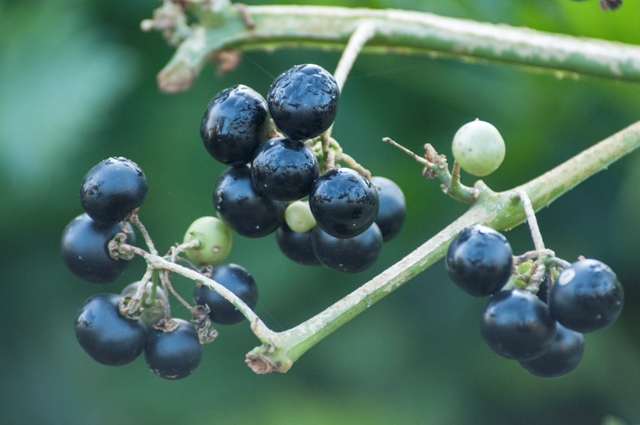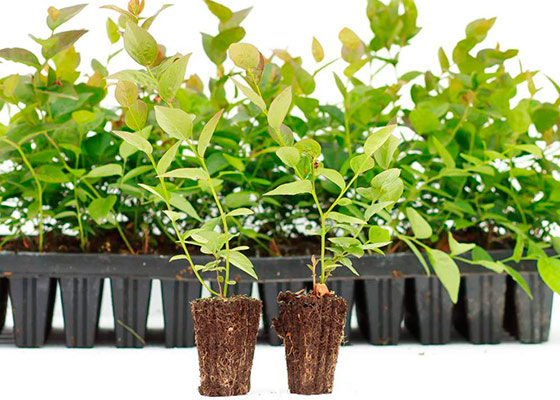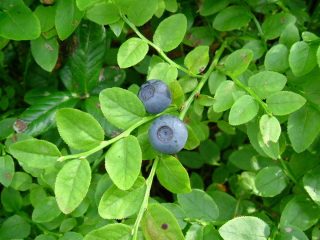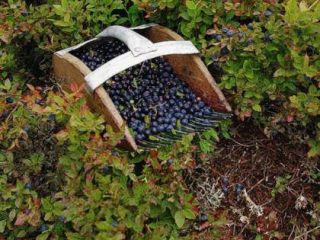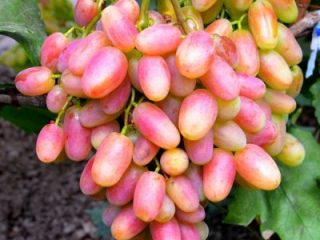Content
Blueberries are a common berry crop that grows in Northern and Eastern Europe, taiga and tundra regions of Asia, and North America. In the wild, it is a low-growing shrub, some species of which do not exceed 10-15 cm. Many gardeners, not wanting to go to the forest for berries every summer, try to arrange their own blueberry in their garden plot. In most cases, transferring a forest plant to artificial conditions ends in failure. Blueberries are accepted, but do not bear fruit. When planting specimens purchased in specialized stores, consumers note that they have little in common with wild berries. Garden blueberry or Blueberry tree is a hybrid species designed to be grown outside natural conditions.
Photo of garden blueberries:
Description of blueberries
Garden blueberry (Vaccinium corymbosum) is one of the variants of the name Highbush blueberry, selectively bred in North America.Several dozen varieties are used to produce large, beautiful berries and in landscape design.
The blueberry tree is a vigorous, spreading deciduous shrub, its height depends on climate and conditions, varies from 1 to 3 m, the diameter of the crown reaches an average of 2 m. The root system of blueberries is fibrous, densely branched. The stems of garden blueberries are straight, strong, and grow longer each year due to young growth. The shoots are medium or thin, slightly ribbed, green or greenish-red, pubescent, shiny. The growth buds of the blueberry tree are small, oblong, pointed, located throughout the shoot and in the axils of the leaves. The flower buds of the blueberry tree are light green, spherical, formed on new shoots - 1 apical and 2-3 lateral, bloom in May. The leaves of garden blueberries are medium in size, green, oval, smooth, shiny, even or finely serrated at the edges. They turn red in autumn and fall off by winter.
White or pale pink, pitcher-shaped flowers are collected in racemes, drooping inflorescences. The corolla is fused-petalled, 5-toothed. Blueberries are round or slightly flattened, up to 2.5 cm in diameter and weighing 1.4-1.9 g, sweet and aromatic. The color varies from blue to almost black, the skin of medium thickness is covered with a bluish coating, the flesh is light and dense. The fruiting time of a blueberry tree differs depending on the variety; the average yield is 3-5 kg per bush.
Blueberry varieties
Selection of garden blueberries occurs continuously, new varieties appear with different ripening periods, increased productivity and resistance to unfavorable climatic conditions.According to the degree of growth, they are divided into high and semi-high, and according to the time of ripening - into early, medium and late.
Variety name | Height (m) | Fruiting period | Frost resistance (˚С) | Productivity per bush (kg) |
Aurora | 1,5 | end of August | — 34 | 7-8 |
Berkeley | 1,8-2,1 | end of August | — 30 | 4-8 |
Bluecrop | 1,6-1,9 | July August | — 20 | 6-9 |
Blugold | 1,2 | mid July | — 34 | 5-6 |
Bluejay | 1,5-1,8 | July August | — 32 | 3,5-6 |
Bleuetta | 0,9-1,2 | July | — 26 | 4,5-9 |
Herbert | 1,8-2,2 | mid-August | — 35 | 5-9 |
Huron | 1,5-2 | July | — 20 | 5 |
Darrow | 1,4 | July August | — 28 | 4-8 |
Jersey | 2 | end of August | — 4 | 5-6 |
Denisblue | 1,5-1,8 | July August | — 25 | 7 |
Draper | 1,5 | July | — 20 | 7-9 |
Duke | 1,2-1,8 | July August | — 30 | 6-8 |
Legacy | 2 | August | — 20 | 9-10 |
Liberty | 2 | July-September | — 30 | 5-6 |
Nelson | 1,5 | mid-August | — 28 | 8-9 |
Northcountry | 0,4-0,9 | July August | — 35 | 2-3 |
Northblue | 0,9 | August | — 35 | 2-3 |
Northland | 1 | mid July | — 35 | 6-8 |
Patriot | 1,5 | July August | — 30 | 7 |
River | 1,7 -2 | July | — 29 | 8-10 |
Spartan | 2 | July | — 35 | 4,6-6 |
Thoreau | 2 | August | — 28 | 9-10 |
Top hut (blueberry-blueberry hybrid) | 0,4 | July August | — 45 | 5 |
Hardiblu | 1,8-2 | August | — 30 | 7-9 |
Chandler | 1,5 | Aug. Sept | — 34 | 7-8 |
Elizabeth | 1,6-1,8 | August | — 32 | 4-6 |
Elliot | 1,5-2 | September October | — 20 | 6-8 |
In the Central Siberian Botanical Garden, semi-high varieties of garden blueberries were bred, not distinguished by high yields, but resistant to major diseases and able to withstand frosts down to - 43 ° C. Universal varieties of blueberry trees recommended for cultivation throughout Russia: Blue Placer, Divnaya, Shegarskaya, Taiga Beauty, Nektarnaya, Iksinskaya, Izyaschnaya.
Recently, some gardeners have become interested in growing a plant called Blueberry forte (or Sunberry). This was probably facilitated by the advertising campaign of the drug of the same name for eye health. In fact, the shrub has no, even the most distant, relation to blueberries - it is an annual of the nightshade family. The growing conditions for Blueberry forte are radically different from those created for garden varieties, since it is a completely different species.
Features of growing blueberries in the garden
The blueberry tree is very demanding on climatic conditions; for successful fruiting and ripening of shoots, the summer must be warm. Most varieties have high frost resistance, but in the absence of snow cover the plants may freeze. Spring return frosts down to -1 ˚С do not harm garden blueberries. The shrub begins to bloom in May, ripening in July-October, depending on the variety. The fruiting period of garden blueberries stretches for 1-1.5 months, which allows you to collect fresh berries for a long time. Cross-pollination increases the volume and quality of the harvest; several specimens with the same flowering period should be planted in one area. With proper care, a blueberry tree lives 40-50 years.
Planting and caring for garden blueberries
To successfully grow garden blueberries in the country, you must follow a number of rules that provide them with favorable conditions for rooting, development, fruiting and wintering.
Selection and preparation of a landing site
You should choose a sunny area for planting a blueberry tree, preferably not on the south side. It should be well protected from winds, cold air should not stagnate in it. Garden blueberries grow well in light, moist, well-drained nutrient soils with water lying at a level of 40-60 cm from the surface. Sandstones and loams with a pH level of 4.5 - 5.2 are preferred. To plant a blueberry tree, the garden plot should be prepared a year earlier - to stabilize and enrich the soil.
Heavy soils must be loosened by adding sawdust, river sand, ground bark or plant humus. It is favorable to sow green manure on a garden plot and then incorporate it into the soil.
Preparation of planting material
Purchasing high-quality healthy seedlings is an important condition in cultivating bush blueberries. Particular attention should be paid to the condition of the roots. The open root system of garden blueberries requires special conditions for transportation and temporary storage, in particular, timely and sufficient moisture. No one can guarantee the health and quality of such seedlings. Preference should be given to two-year-old blueberry trees grown and sold in special containers. If you choose 5-6 year old plants, this will be a more expensive and “early ripening” option - after spring planting, you can harvest the first harvest of garden blueberries in the summer.
How to plant blueberries
Garden blueberries are planted in spring (April) or autumn (early September). In the first case, the risk of damage to the plant by rodents and freezing in the event of a harsh winter is eliminated. In the second, they will have time to take root well before the cold weather; during this period, blueberry seedlings are less susceptible to pest attacks and diseases. In the southern regions and temperate latitudes, it is better to plant a blueberry tree in the fall, in the northern regions - in the spring.
Planting pits for garden blueberries with dimensions of 1x0.6 m are prepared in advance, 15-30 days in advance, the distance between them should be at least 2 m. Drainage made of small stones or broken bricks is laid at the bottom.Add acidic peat, rotted pine litter, 1 tbsp to the soil removed from the pit. l. complete mineral fertilizer. 15 minutes before planting the blueberry tree, the roots need to be soaked in warm water; there is no need to remove the earth from the roots. After placing the blueberry plant in the hole, you need to water it generously and cover the roots with soil.
Watering and fertilizing
Garden blueberries require regular watering, and do not tolerate stagnation of moisture in the roots or drought. The top layer of soil should always be moist - to maintain a favorable level of humidity, it is recommended to mulch the tree trunk area. The blueberry tree is fed three times a season with complex mineral fertilizers (1 tbsp per m2) or special preparations “Fertika Universal”, “Fertika Lux”, “Solution”, “Aciplex”, “FLORTISGOLD”. To maintain the optimal soil acidity level, once a month it is recommended to water garden blueberries with a solution of citric acid (1 tsp/10 l of water). All fertilizing is applied to the tree trunk circle, in the mulch.
Trimming
Young garden blueberry bushes are not pruned for 3-4 years. Subsequently, it grows with thickening shoots. If blueberry branches do not receive enough light, the berries will be small and sour. To avoid this, the blueberry tree is pruned. It comes in 3 types:
- Sanitary – diseased, dry and damaged shoots are removed, carried out in spring and autumn.
- Formative – used on blueberry bushes from 4 years old, its purpose is to thin out the crown.
- Rejuvenating – from a 10-year-old plant, branches older than 6 years are cut out.
Even in favorable conditions, in the absence of timely pruning, blueberries in the garden plot will not bear fruit well; a bush overloaded with branches will produce a small number of small berries. It is optimal if the bush has 5-8 strong branches growing from the rhizome or stumps located near the ground after rejuvenating pruning. Every year, the crown of a blueberry tree needs to be thinned by a third, root shoots removed, and annual shoots shortened to 1-2 buds. After the event, garden blueberries need to be fed with ammonium sulfate and the soil mulched with acidic peat.
Preparing for winter
Despite the fact that most varieties of garden blueberries tolerate frosts down to -35˚C, they need to be insulated for the winter. If the winter is harsh and snowless, plants may freeze, even to the point of their death. The first thing you need to do before the onset of cold weather is to water the blueberry tree for the winter, 4-6 buckets of water for each plant. Then you need to carefully cover the roots by pouring a thick layer (20 cm) of soil or mulch in the tree trunk circle. Tall blueberry bushes are bent and pinned to the ground; this is not necessary for low-growing ones.
Garden blueberries need to be covered with the onset of the first frost - with spruce branches, agrofibre or spunbond. Subsequently, you will need to throw snow on this shelter; this design will create reliable protection from frost.
How to Grow a Blueberry Tree from Seeds
Garden blueberry fruits contain a large number of seeds - this encourages many to try to grow a seedling on their own. There is nothing complicated in the process, it just takes time and patience. Seeds are selected from fully ripened healthy large fruits. After mashing the blueberry pulp into a paste, the seeds are separated and immersed in water. Those that float are discarded, those remaining at the bottom are immediately sown (in August) or dried and stored in a paper bag until April-May. In the latter case, they need to be stratified for 3 months (starting in January). Blueberry tree seedlings are grown in special containers.
Blueberry seeds are scattered on the surface of the nutrient substrate and covered with a 3 mm layer of sand. The container is covered with glass or film and placed in a warm, bright place. Garden blueberry crops need to be watered and ventilated periodically. After 4 weeks, the first shoots will appear. After the formation of a pair of true leaves, the sprouts are moved to separate containers for growing. During this period, blueberries need to be watered abundantly and mineral fertilizers applied. With the onset of consistently warm weather, blueberry tree seedlings are transferred to a “school” - a temporary site, where they will remain for 2 years. Only after this can they be moved to a permanent location. Growing a blueberry tree at home from seeds is a long process aimed at breeding and selecting the strongest and most promising specimens.
Blueberry propagation
In addition to the seed method, garden blueberries also reproduce vegetatively. To obtain new seedlings, individual parts of plants are used:
- Cuttings – in February-March, planting material 20-25 cm long is cut from well-ripened and lignified annual shoots 2 cm thick.
- Young shoots – at the end of June, young shoots are plucked from the stem and the lower leaves are removed.
- Layerings – from April to September, the lower branches of the blueberry bush are pinned to the ground and sprinkled with sawdust and fertile soil. After rooting, the branch is separated from the mother plant and transplanted into a “school”.
Propagating a blueberry tree by layering is the least popular method; the branches take a long time to take root (2-3 years), allowing you to get a small number of new plants.
Diseases and pests
Garden blueberries are highly resistant to diseases and are weakly affected by pests. Under unfavorable conditions and insufficient nutrition, the plant's immunity decreases, it becomes susceptible to fungal and viral infections - stem cancer, rot, Phomopsis, red leaf spot, mummification of berries, mosaic. Since such diseases spread through the blueberry tree very quickly, you need to act after the first symptoms appear:
- leaves become stained, curl, fall off;
- bark, branches, inflorescences dry out;
- berries and shoots stop developing and die.
Affected parts of plants are removed and burned. Blueberry trees are treated with Topsin, Euparen, and Fundazol. To prevent fungal diseases, the root zone is sprayed with Bordeaux mixture twice a year.Before flowering and after picking berries, it is recommended to treat garden blueberry bushes with Skor, Tercel, Tridex, and Fufanon.
Pests attack the blueberry tree to a lesser extent and do not cause much harm. Sometimes it is enough to simply assemble them by hand. Most often, caterpillars, aphids, flower beetles, leaf rollers, bud mites, and beetles can be found on a garden blueberry bush. If the mechanical method of control is ineffective, you should resort to popular insecticides: “Fitoverm”, “Aktar”, “Dendrobacillin”, “Bitoxibacillin”.
The harvest of blueberry trees and birds is damaged; to protect the bushes, they need to be covered with fine mesh.
Conclusion
Garden blueberries are a plant that is just beginning to gain popularity among Russian gardeners. Planting and caring for it does not require much hassle and is not associated with any difficulties. New varieties intended for cultivation on an industrial scale appear regularly. By creating favorable conditions and following the rules of care, you can annually obtain a stable harvest of beautiful, large, tasty and healthy berries from a blueberry tree.
Reviews from gardeners about garden blueberries


